Working Smarter With AI - PODCAST TRANSCRIPT
June 20, 2025 at 4:00 p.m.Editor's note: The following is the transcript of a live interview with Dave Chapman of Estimating Edge and Marty Cornish, founder of Workpack. You can read the interview below, listen to the podcast or watch the recording.
Intro: Hello and welcome to Coffee Conversations. My name is Heidi Ellsworth and this is coming to you from the Coffee Shops. We are so excited to have you here today to talk about AI. Wow, this is top of mind. It is changing our businesses daily and so we are bringing experts in to have a conversation today just about how this is going to be affecting your roofing business. We see it, we know, we're talking about it and today we're really going to dive deep.
So first, some housekeeping. Of course, this is being recorded and it will be available on demand within 24 to 48 hours. So stay tuned for that. Share it with your friends, share it with other roofing professionals because this is the kind of information that makes our industry great, takes us to that next level. Also, the chat is open, of course it is. We want to hear from you. This is a conversation. So please, in the chat, let us know where you're from, who you are, your company, what kind of company you have. And then throughout the hour, please let us know your thoughts, your comments and definitely your questions because as we always say, this is a conversation. We need you in that chat making it all happen. So let's get started on this exciting program of Working Smarter With AI. Here we go.
So first I would like to thank our sponsor, Estimating Edge. I have to tell you, we have worked with Estimating Edge for many years. It is an amazing company, always on the forefront and we appreciate them so much for being the sponsors today. Not only a sponsor but also bringing important topics to all of you for this conversation. That's really what makes it all come together. And as part of that, I am thrilled to have Dave Chapman on the show today. Dave, welcome to Coffee Conversations.
Dave Chapman: Morning, Heidi. Thanks for having me.
Heidi Ellsworth: Ah, can you introduce yourself and tell us a little bit about what you do with Estimating Edge?
Dave Chapman: Sure. I'm the sales director over at Estimating Edge. For those who don't know who we are, we've been working with roofing contractors since 1987 for the estimating side of things. We work probably with 75% of the top 100 roofers in the country. I myself have been with the company now for 24 years, didn't update my slide there, but 24 years working specifically with roofing contractors on the sales, implementations and support side of things. So excited to talk about this topic. It's a totally different topic than we talked about 23 years ago, 24 years ago when people were just moving off of paper blueprints and it's amazing how far technology's come.
Heidi Ellsworth: Yeah, it is amazing and Estimating Edge has really been the leader in bringing that estimating blueprints, all of that to the forefront. So thank you. Thank you for sharing everything that you do and helping the industry as much as you guys have. 24 years, Dave, it's really impressive. I am also very excited to welcome Marty Cornish to Coffee Conversations for the first time. Marty, welcome.
Marty Cornish: Great to be here. Thanks, Heidi.
Heidi Ellsworth: There you are. Great. And can you introduce yourself and tell us a little bit about what you do and your company?
Sure. I'm, again, Marty Cornish, founder of Workpack, which recently sold to Beck Technology and I'm VP of product for Beck Technology. We set out to make it possible for everybody working on the same project to work from the same documents and the same data, starting with AI as making that possible. And all of this AI stuff has to actually have utility in a real business sense and when we started working on it, it was almost starting to become buzzwordy but not even quite and now it's forefront being used every day and changing our workflow. So again, excited to be here. Thanks, Heidi.
Heidi Ellsworth: Yeah, we're excited to have you and really hear about this. So let's get started. I want to remind everybody the chat is open. Good morning, Lorna. I see you there. Thank you. Please let us know who you are, what you do, your companies. Thank you. Fill in that chat and be sure to ask questions as we go. We're going to see some AI assistants helping today too. Very nice. I like it.
Okay, so let's just start at the very beginning and let's talk a little bit about, I know this is the tech stack and we're going to talk about that. I have this up here, but I really want to start with what does the term artificial intelligence mean and who are the players? I think, to your point Marty, it's such a buzzword that a lot of us are just kind of like "AI, AI." But do we really understand what all that means? Can you give us a high level on just introductions for everyone out there who is trying to understand this?
Marty Cornish: Yeah, I mean, artificial intelligence, it's really more like cloud tasks or on-demand tasks or on-demand interns or unlimited interns is one phrase that I've heard used. Just computational power has gotten to a point where you can train AI models, so you're basically training software to do work for you and now there's an additional layer on top of that of AI agents that you may have heard of that are kind of designed to do workflows on top of it.
So AI is changing quickly, but really you should think of it as a tool to help do tasks for you. There are a lot of tasks that can be done right now today using AI and the common ones that people are using every day, I mean, Tesla has self-driving cars now, OpenAI has ChatGPT, there are coding assistant platforms so you can actually generate a whole bunch of software using AI now and some companies are generating like 90% of the software that they write leveraging AI. And so it's gone from being a toy demo almost cool kind of thing a year ago, two years ago to driving a lot of workflows today and will continue to over the coming years. So here to stay, it's not going away and certainly something that you should get on board with. It's helping people move a lot faster, a lot more effectively, be a lot more productive.
Heidi Ellsworth: Yeah, I was going to say productivity is what definitely comes to mind because I mean, I just think in my world of sales and marketing, I personally use ChatGPT and I have seen such a huge influence. But I want to go back to what you said there, Marty, it's a tool. It can't take the place, it can't do your work for you. You have to still have that creative, that brain, the processes. It needs us behind it and I think sometimes that gets lost in that bigger picture of AI with some of the fears of Skynet, all those different things that are out there. What are you seeing just as in the adoption of it as a tool and accepted? Because I think over the last couple of years, people are almost looking down their nose at it like if you use AI, that means you're just being lazy.
Marty Cornish: I mean, this year it certainly is being adopted more and your replacement analogy, the work isn't going away, but it is changing. And so I heard the analogy recently of somebody talking about acting a lot more like the leader of the orchestra, the conductor rather than playing an individual instrument. I use the sports analogy because I'm a former athlete. It's more like being offensive coordinator rather than an individual offensive linemen as a pre-construction and estimating team. So it is organizing the data, giving AI context, delegating, learning how to leverage the tools a lot more effectively. The tools are just a little bit different. They could do more tasks. A lot of the redundant work can be done today with AI.
Heidi Ellsworth: Yeah, that is insane. Okay, so Dave, roofing, you've been in roofing for 24 years or construction overall with Estimating Edge and probably more. I've been same time and so I think a lot of times, people think, "Roofing, yeah, that's fine for everybody else. But how's it really going to help us? Really, is AI going to help?" And I have heard so much out there from contractors who are using ChatGPT in their sales and marketing and their recruiting, writing, all those kinds of things. So what do you see? How is AI, it's coming through Estimating Edge, but just overall in the industry, how do you see roofing starting to utilize it?
Dave Chapman: Sure and that's a great question as far as how roofing is going to adopt AI and what areas of their business can they adopt it. As we know, roofing construction in general, probably a larger part of that construction has always been late to the table as far as technology is concerned. I think the stat is they're second only to the agricultural business as far as adapting technology. And now that we have younger ownership and new owners taking over the different generation than when I started, they're a lot more tech-savvy and more open to using technology.
And really from the estimating side of things, we're really seeing it help with working with Marty in automating things on the takeoff side of things and also helping integrate directly into the estimate itself. But this graphic that we have up here not only talks about the project life cycle, but this is really also what a typical tech stack would look like for a contractor these days, from their CRM for managing their customers, to bid management, to estimating, scheduling, project management, all the way through payroll and job costing. All these areas are new technology for roofing and AI I believe is going to help each of these areas talk to each other. Not just helping us on the estimating side, but also helping on things like writing scope of work, analytics on business practices and where you should be estimating, where you should be going after jobs, things like that. AI is really going to be moving us forward and you'll be surprised within the next year how much more forward we are with it.
Heidi Ellsworth: Yeah. I mean, I've heard of contractors and folks who are actually taking some of their lists, their prospect lists and putting it into AI and saying, "What fits our model the best? How should we do this?" There's a lot more that's going into this data-wise than I think we're even thinking about. And then when you really start getting into the estimating and everything that's there, I mean, talk about a time saver and bid management and all of the things that you have here. Marty, you've been working on this. How is AI going to really come in and really create some huge productivity gains in throughout this tech stack?
Marty Cornish: We just have focused on quantity takeoff for the last six years and we've automated a lot across a wide variety of different trades so far inside Workpack and we have an integration with The EDGE. Roofing likely coming next year is sort of where we have it roadmapped, so maybe jumping a little bit ahead, but it's almost there for a lot of the takeoff and estimating stuff and we're probably the furthest along. But we detect walls, doors, windows, rooms, labels, tables, symbols, patterns, corners, steel columns, steel beams inside of construction drawings. And obviously that's a massive mouthful, but you give the construction drawing some context, it generates the takeoff, then you edit it to make it your own and then export it to use it in your estimate.
And so you have to provide the work that you want it to do, just like you would delegate it to an intern. You give it some information about what you want, then it generates the work. It does it in two minutes rather than two hours or two days and then you can edit it however you want to to make it your own and it's not really yours until you edit it.
All of this estimating requires estimating assumptions, context. There's often things that are not shown on the drawings. There's all this tribal knowledge that remains incredibly important and there's all this contextually relevant information that's company dependent. Do I own lifts? Do I rent lifts? What kind of labor rates do I have on different things? What kind of pricing do I have on materials? Can I stub out material? Those assumptions are not things that AI is going to have any insight into, at least not yet and probably not for a while, ingesting all of your company data and providing company-specific insights. It is really more generalized knowledge today and specific knowledge on what you give it within that context window of like, "This is what I'm looking at right now. This is the task that I've been given right now, so I'm going to go do this and generate this."
And then good software around the AI models. So there's the AI model which has to actually do something useful for that task and then there's the software around it. The software around it enables workflows that make it possible for you to edit the AI-generated work or take that AI-generated work and integrate it into other systems or move it, do what you want with it.
Heidi Ellsworth: And I think that's key, isn't it? I actually just wrote an article on this about AI is a tool and that it is a tool that we have to be managing because, I like what you said, tribal knowledge. And so you think about that, Dave and where we're at with contractors and how they estimate and how their business runs stuff. You can't just think it's a one and done. It takes some work to put it into to make sure that it's working in the right ways.
Dave Chapman: Yeah, absolutely. It's a great tool and it will automate some of the more redundant tasks that are required for an estimate, but there's always going to be that human element of being able to look at your company. What crew am I sending out there? How quick and efficient are they compared to another crew? What am I going to be putting in here for my production rates on the estimate? Things like that. And AI will help analyze jobs across the previous jobs or historical jobs and look at that historical data to create models for those production rates, but there's always going to be the human element of looking at that particular job, what's around that job, access and being able to put that element on there. But AI is going to be moving, not just analyzing historical data for production, but historical pricing and being able to do predictive models for future pricing and automating that side of your estimate as well.
Heidi Ellsworth: Well, I think for everyone out there, we have a great slide here that I would love for you to go through of how this really works with the estimators and how... Because one of the things and this is what I was trying to set this is, a lot of people go like, "AI, okay, that's ChatGPT or Claude or whatever is out there." But really where I think the power is, is as we look to our software providers like Estimating Edge, when we look to our software providers and they are incorporating AI into our everyday work things to make it all come together, so it's already there. So Dave, take us through this slide. And Marty, I'm going to start with Dave and then I would like both of you to talk through this slide and how AI is incorporating this with takeoffs. And what's it doing really real world for roofing?
Dave Chapman: It's a huge time saver for our customers on the takeoff side of things, especially right now. That's, I think, where AI shines the brightest for our construction field is taking that redundant task. Back in the day, people were using a stretch ruler to measure things out and then if they were savvy in the nineties and early 2000s, they got a digitizer board to measure and get their quantities that way and then it became online measuring. Well, it still took time and it was redundant and a mess and AI's really helping to straighten out that bottleneck. Then The EDGE itself has a translator, we call it EDGE Smart Takeoff, where it translates that AI data and AI models and allows us to import it into the estimate to speed things up right there. I think that right now is where and Marty, because that's what his specialty is, can probably speak more to that as far as how it's affecting the contractors right now.
Marty Cornish: For sure. What we saw at the beginning when we started Workpack was that people weren't collaborating effectively enough and takeoffs took too much time. So when we started, we just started trying to figure out, "Well, how do we automate as much of this workflow as possible?" When we were able to detect all these different objects with AI over time, we built these models to actually generate it. Then we started looking to partners, like Dave's team at Estimating Edge and how can we integrate this into the estimate. So we just handle the takeoff side of things. You can generate takeoff inside Workpack, export it to The EDGE and then we also have a similar integration with DESTINI Estimator for general contractors, which is now my parent company, Beck Technology. So that enables the takeoff workflow to be a heck of a lot faster, consistently four to 10 times faster for our users and sometimes up to a hundred times faster for some scopes and trades. So I mean, it's producing almost unbelievable time savings for a lot of our users.
Heidi Ellsworth: When you are really looking at it and we have some good comments in here... And I want to apologize, I meant to say this at the very beginning and as usual, I get excited and get into the topic. But Denver Riggleman was going to be on this Coffee Conversation with us today. He's also a leading expert in AI. And his wife, he couldn't make it. He had a family emergency basically and everything is fine. So no worries for those who might be here looking for Denver. He will be back soon because he's going to be joining us for a couple different things, so no concerns there. Second of all, we did have a couple of people come in late and we just wanted to put out there. Marty, can you just real quick, your company again and what it does? And then Dave is is with Estimating Edge and so we'll have you guys do that just real quick for [inaudible 00:21:43].
Marty Cornish: Again, Marty Cornish, founder of Workpack. We recently sold to Beck Technology, which flagship product is DESTINI Estimator. We serve almost a majority of the ENR 400 now.
Heidi Ellsworth: And doing this incorporating AI into estimating and into workflow.
Marty Cornish: Correct, yeah, with quantity takeoff primarily. And there's one good question that I'll answer right after Dave gives us the introduction.
Heidi Ellsworth: Yes, so Dave, go ahead. Just real quick with Estimating Edge.
Dave Chapman: Sure. Again, Dave Chapman with the Estimating Edge. I'm the sales director over here. The EDGE has been working in the roofing industry for upwards of 38 years. I've been with them for 24 of those years in various aspects in various positions, but always trying to keep on the forefront of technology for roofing here.
Heidi Ellsworth: So bringing the technologies in, great question came in from Marty, so let's-
Marty Cornish: Yeah, Marty Klein.
Heidi Ellsworth: It's from Marty to Marty.
Marty Cornish: Yeah, totally. The quality of the design impacts everything throughout the workflow and AI can only detect whatever's in the drawing. So we for general contractors start all the way at conceptual level drawings and then are adding some version control features so that they can have version control over the documents and version control over the takeoff so that they can layer it on and then have some advanced overlay features and things. But with bad drawings or early-stage drawings, it's only going to detect what's there. So all of the questions that exist today are still there that, if you're just taking off a flat roof, it's clicking a couple of squares and drawing things, so not hugely time-consuming. But if it's a more detailed project with a lot of nuances, a lot of penetrations and things, there's more to pick up, more to detect and a more time-consuming process, which is frankly why we focused on some of the interior trades earlier because those are more time-consuming. So again, what we detect inside Workpack today are walls, doors, windows, rooms, labels, tables, symbols, patterns, corners, steel columns and steel beams and match lines actually.
Heidi Ellsworth: And the question was from Marty that disagree that takeoff is the bottleneck. He spends most of his time trying to answer the question, "What do you want? How will AI output good info if the input from the design team is garbage?"
Marty Cornish: Yeah, probably should have called out the question as well.
Heidi Ellsworth: No, that's okay.
Marty Cornish: How will AI output good information if the design is garbage? Yeah, again, if they're conceptual-level drawings, there's very limited information in the drawings, AI can only do whatever's there. So whatever you give it, whatever context you give it, that's why providing context, being a context engineer, thinking about it that way, being a delegator, you're providing information for the AI model to have enough context to generate the information that you're looking for. And if there's not that much information from the design team, nobody has enough information.
Heidi Ellsworth: Enough to do. Well and one of the things you used earlier, your example of the sports instead of being really the... Say that one again, your sports analogy.
Marty Cornish: The offensive coordinator rather than an individual offensive linemen. It's driving the workflow, controlling the team, driving the process a lot more.
Heidi Ellsworth: Yeah, there's going to be a lot more and I think this is where a lot of people are like, "AI is going to take over. I'm going to lose my job," and stuff. That's not going to happen because it needs to be having people like Marty who are saying, "Okay, wait a minute. These blueprints, this information, whatever we're getting on the roof is not going to give us information we need for good output." The tool of AI just takes whatever you give it and puts it into hopefully those things. So how can contractors know that? Marty, how do you work that process of really being able to work with a design team to be able to get all the right information? It's probably the same with or without AI.
Marty Cornish: As a subcontractor, it's hard because you have no leverage. You ping the GC over and over again. I mean, I see the workflow changing from GC to sub a little bit over time, but them being able to provide more information faster. I mean, to your point, the work's not going away, but it is changing. Client demands are increasing, deadlines are shrinking. People want more information faster across all industries and construction's no different. And so we're just going to turn around pricing faster. That's really the thing. It is mostly the same kind of workflow for what do you want and that with AI almost becomes even more of the bottleneck. If that's your current bottleneck, Marty and others, figuring out what people want is still the problem, maybe increasingly so. Even with building software, you have to figure out exactly what you want to build. The limitation now is not building because AI can do it very quickly. It's like, "Okay, well, let's specify things. Let's scope it out, let's figure out what's most important to do, prioritize things," all of that.
Heidi Ellsworth: Well and I think to that point, there's a lot of folks out there and Marty, thank you for your response. He said, "Thank you for the response. Your answer confirms my suspicion that AI developers should first focus with design teams before trade contractors." I want to hit on that because I do think your earlier comment of garbage in, garbage out is so true and AI is just going to pick up whatever is there. We're seeing that on all sides, not just on the estimating side, but we see that you put in bad information, it's going to pull bad information from the internet. It's going to write an article, none of it's true, all the facts are wrong. And so you have to have the people out there in front of it really working with that design team overall. What are some other misconceptions, Marty, that are really out there along that line about AI that can trip up contractors?
Marty Cornish: Well, I mean, AI already is part of many software applications and will continue to be. And so it's almost like when we went to cloud, whatever 15 years ago or so. Estimating Edge went to cloud a few years ago. We at Beck Tech are in the process of moving to cloud. A lot of the legacy tools are moving more to cloud and the industry is broadly moved to cloud. So it's sort of like that. It's like the cloud migration, everything being cloud software versus desktop software. Now everything has AI in it.
There isn't just one AI overlord and there's not one group of AI developer. Each company has their own AI-assisted workflows that it will be infusing in every product. And we train our own models for the most part. We're not just leveraging existing ChatGPT clone, open-source model kind of things because construction documents are so specific, but we now are starting to use ChatGPT and others to provide context for our software. So it's almost like use the AI to provide context for our AI to work more effectively.
So again, it's changing a lot. Even being in it, it probably feels, if you're outside of this, just watching a race car drive by. And so I want to try to make that a little bit more accessible. It's just like, okay, one, it's just a tool. Two, the workflow is not going away. Work is not going away, but it is changing. And AI is not going away. It's here. And so figure out, maybe the starting point is just ask ChatGPT a couple of questions about anything you want or Grok or any of these large language models and you'll get some really cool answers and you can start to play around there. That's probably the most accessible way, easy way to do it. And then a good question from Chris too for Dave about integrating AI into the process, maybe into The EDGE.
Heidi Ellsworth: Yeah.
Dave Chapman: Yeah, absolutely. Go ahead, Heidi.
Heidi Ellsworth: Oh, I was just going to say, I think this brings us to our next slide. I want to say, Chris, thank you. Great question. It takes us right where we're going. So Dave, AI is imported into the process. Can you expand how this is done? Let's get down to brass tacks.
Dave Chapman: So once we have those takeoff models and data from Marty's software, we basically are using what we call EDGE Smart Takeoff to translate that data into the estimate because the measurements are great and the quantities are important, but we need to be able to tell it, "This is a wall flashing. Where's the curb flashing? Are we going to need what type of drip edge metal?" Things like that, that we're going to have to translate those quantities into assemblies inside of The EDGE. Our Smart Takeoff basically translates that for us and lets us adapt those quantities into the correct assemblies inside of The EDGE. So yeah, there's still that human side of things where you have to direct that data to the correct areas and Smart Takeoff does that. It's kind of, while you're inside of the estimate of The EDGE, we're saying, "All right, here's our wall flashing, our curb flashing or our roof drains and this is the quantities that we're going to assign to it," and then it applies it to the takeoff inside of The EDGE for you.
Heidi Ellsworth: Dave, since Chris asked this question, Chris Salazar with Karnac, is this something where the contractors... I mean, they already are working with their manufacturers within The EDGE. And is this all the AI? Is there anything that they need to understand of how is that going to affect how the materials are put in, how things are handled? Or is this just automating faster from understanding what's on the roof through that system? Go a little bit deeper.
Dave Chapman: Yeah, so it is essentially what you just said right there. It's automating the process of what's on the roof to what we need to apply material-wise. As far as The EDGE is concerned, we already work with all the manufacturers and have their products and pieces and parts and contractors can build the specific systems that they want to use. If it's an EPDM roof or a PVC roof or whatever that they're going on there, they have the system built as far as what parts and pieces are going to go on there. It's just applying those quantities to it inside of The EDGE. And I'll even, besides that part of it, the takeoffs and the collaboration there get into some of the areas on the CRM side of things and things like that, that AI is going to be helping the roofing contractors.
Heidi Ellsworth: And how's that with the CRMs?
Dave Chapman: Oh, well, we've looked at some of these that are out there already, the generic CRMs and roofing-specific CRMs that we want to incorporate possibly into our white space. They come along with technologies now where you can look at past data. AI can help automate the sales process as far as creating your marketing materials, creating those emails to keep reaching out to your customers, automating that reach out to your customers. AI is going to help on that side of things. And then once you've run bids and run jobs and you have data coming back from that, you can actually look over a period of time and say, "I want to look at all the jobs that I did in this particular zip code," and have AI do some analytics as far as what my typical pricing looks like, what's my profit margin on material, what my actual production rate is for certain tasks and being able to create predictive models for future jobs there.
And then looking at your win-loss ratio, seeing what particular areas you're having more success and AI is going to be doing all those analytics for you. Do I do more marketing in this particular region because my profit margin is higher and I have a higher success rate of winning those jobs? Certain GCs over other GCs, all those types of analytics and CRMs are basically the central point for gathering all that data is where AI is also going to be helping roofing contractors tremendously in the future.
Heidi Ellsworth: So one of the things that I think happens out there right now is, we hear it at the Coffee Shops, we hear a lot of people saying, "AI, AI, AI." They're using it and , "We have it and we're doing it," but sometimes it's just hype. Especially over the last couple of years, everybody just wants to be on that forefront of the hype. And for both, Marty, you and Dave, how can contractors evaluate the difference between a company that's just hyping AI compared to a company that's truly using AI to make the processes faster, to make them more accurate and to work better within their company? Let's start with Marty.
Marty Cornish: One, I would start with the companies, the software providers that you're already working with. Dave's a perfect example. Their team loves working with us, we love working with them and they talk to their customers about Workpack and we talk to our prospects and customers about The EDGE. So that's a great place to start, I would say, about what's real and what's hype because if you're just looking at the market, it is hard to do a full software evaluation. Sometimes it takes a year to really do a full evaluation. If you start with your existing provider and just say, "Hey, what's real, what's hype that's out there? And can you integrate with the real ones," then that's a good place to start.
Also, I'd add for roofing specifically, I mentioned that the things that we detect inside Workpack today. The roofing scope specifically, there are some symbols and things. You can detect penetrations today. You can detect exterior wall versus interior wall today to split those things out, so it's almost there today for roofing specifically. But I would say our product is probably more hype than real for roofing specifically and that's obviously not in my best interest, but we've always taken the approach of actually selling something useful rather than selling smoke and mirrors and having angry customers.
And so for the trades that we do serve, it's very, very useful and we have it back of the napkin to do this for the roofing scope specifically end to end next year, which it's already, again, most of the way there. We don't detect things like pitch. We do detect patterns on roofing plans. You can select that a specific plan is a roofing plan and detect certain things that way, but it's not specifically focused on that. We do have full manual takeoff functionality that you can export directly into The EDGE today, but most of the value for people starting to use Workpack today is in the AI generated takeoff and saving all this time.
And so for the wall and ceiling contractors, flooring contractors, doors, windows and hardware, general contractors doing different scopes, concrete, so there are a bunch of different trades that use Workpack every day on every project for their workflows and then can right now today, all the interiors do this today, export to The EDGE, get all their quantities right there, can just map 1, 2, 3, 4, all the way down the list to their conditions and be completing their work a huge amount faster.
Heidi Ellsworth: Dave, talk a little bit more because to this point, how do contractors have this conversation with their software providers? Because I think sometimes, I mean, I know in what I'm working on sometimes, I know in the background it's using AI. But I don't know, I just hit a button and that button does something for me and I'm off to the races. So as a contractor, how do you know? Is it just one day, all of the sudden everything's moving faster or not?
Dave Chapman: Yeah, it can be overwhelming trying to keep up and keep tabs of what's going on there and being able to sort through what type and what isn't. I think Marty touched on it and it's a great point. We just talked about this last week when we were talking about the tech stacks at the MetalCoffeeShop is talk to your trusted providers. At The EDGE, we've been working with some of our customers, I think over 70% of our customers have been with us for 15 years or longer and we were, besides maybe their accounting software, their first foray into technology and software inside of their business. So we're pretty well-trusted and they come to us a lot for suggestions for other softwares like CRMs, AI takeoff. That's why we talked to Marty about that.
So talk to the people you trust and whose opinions you value. RoofersCoffeeShop is another source to go to and find out some good information. You guys have a community to talk to. The associations have communities that talk about this to help you find what's actually been working in the industry so far, instead of, being the first to dip their toes in the water and then jump off the cliff is a scary thing. So chances are a lot of people have already done it and you find out what they trust.
And Marty's right, we are working with them. The EDGE works with some other trades, like the interior contractors and fireproofing and concrete contractors. And the technology's proven there and it's going to be there for the roofing side of things as well before you know it. So yeah, I think the biggest thing to take away from that is talk to the software providers that you trust.
Heidi Ellsworth: Yeah, that's the thing because I think a lot of times our software providers in the roofing industry are going to be incorporating this. Like I said, we may not even realize it, but they're doing the testing out front. But then also, as we start looking at things, there are success stories. I talked to a lot of contractors every day who are using AI in a lot of different ways. So Dave, what are some of the success stories you've seen or heard from contractors really about that, some of their success stories with AI?
Dave Chapman: Yeah, I think, touching on what I've mentioned before with the CRMs and automating the sales side of things, I think is where we've seen the initial success for a lot of customers in the roofing side of things is reach out. Scheduling those reach outs, writing the content for those reach outs and following up on if anybody replied to any of those reach outs. I think initially those are the biggest success stories on the roofing side of things that I've seen.
Heidi Ellsworth: And one of the things I would put out there, just as what I've heard and how we've experienced it, is whichever software you're using in AI to do these kinds of reach outs, writing letters, doing data analysis, all of that, be sure you're doing the paid version because at least this is what everyone's telling me and Marty, maybe you can help on this, but using the paid version is going to protect your data better than free versions out there. Is that an old wives' tale? Is that a myth, Marty or is that true?
Marty Cornish: No, it's not an old wives' tale. I mean, most of that is explicit in their privacy policy and terms of use. So yeah, I mean, if you're using a paid version, your data is your data generally. That's our approach to customer data as well as your data is your data. We don't really do free trials, so there's not a free version of Workpack. But for ChatGPT, Grok, others, typically the free versions are going to use your data for training models or can. They have the right to if they want to. And then if you pay for it, then your data's your data. Yeah, I mean, especially with sensitive information, sensitive project information that you don't want used for anything else, then you should definitely use a paid version from a trusted provider and you have to decide who those trusted providers are.
Heidi Ellsworth: Right and that may be something too and I can see us doing some follow-ups on this because a lot of this is trusted providers within our industry of roofing software companies that are doing things. But obviously we're all using software that is not just for roofing. It's ChatGPT or Claude or whoever it may be out there. And so really understanding your rights and how that works because I tell you what, it does get to know you. As that roofing company is putting their information in, it starts tailoring it down to what you want. It's a great tool.
But going back to the estimating part of it and really even earlier to Marty's comment, one of the things that I've seen and so Dave, you and I can compare on this. In over 30 years in the roofing industry, I have seen a lot of resistance to technology, a lot of resistance to the culture of bringing technology in. Again, like we talked about, "Losing our jobs, not accurate information, it's lying to us. I'm going to do this the old-fashioned way of estimating. We're a lot safer that way." What are some of your suggestions as you're working with your customers on bringing in, as they start using the smart estimating and using more of these things? How do they develop trust and that culture of innovation within their company to try these new things to really help them? Let's admit it. There's a lot of cynicism in the roofing industry because there's been a lot of failures here and there with new softwares, new different things, not The EDGE, but different things. So how do you help your customers bring that into the culture of their business?
Dave Chapman: Yeah, I mean, you're right. There's been some pushback on using technology or adapting technology with roofing contractors historically. That's changing drastically in the newer generations now, but a roof is a roof. There's nothing fancy about it. There's a correct way to put one on there and there's an incorrect way to do it and that's why technology isn't going to change that. You still have to have quality materials, quality craftsmanship in order to have a successful business.
But as far as adapting technology, don't be afraid. I think a lot of people have been burned once or twice trying to use certain software tools or technology and it prevents them from trying to look at it again. So my big thing is don't be afraid. I've seen people that did not want to come to an estimating software outside of their yellow papers and spreadsheet because they've been burned in the past and it's usually more of a, it could be a software error, hopefully not, but it's usually a user error or just not knowing what they don't know. That's a big part. But don't be afraid. Talk to your peers, talk to your trusted software providers and give it a shot. I mean, other people have done it. Again, back to the lemming story, you don't want to be the first one off the cliff, but some people have already made that jump. Talk to them and trust what they say.
Marty Cornish: Yeah, I would say, Dave, you should take that question that way because EDGE has been around a while. It works. The customers love it. They've loved it for years. And so you should take the question that way. I'd take it the other way is that, one, don't trust the AI. Two, don't jump into these tools too quickly, even though this is my bias and my thing.
So that being said, you should try. You shouldn't fully adopt. You should try the tools and see what works and explore because they're moving very, very quickly and will get to the point very, very quickly for roofing specifically where they will add a lot of value. So my guess is, I don't know if you put a calendar date in like 12, maybe 15 months, this is something that you can use every day on every project and it'll be quite useful for you. Not today. I wouldn't jump with two feet into any AI takeoff workflow certainly.
And then also, some of these other AI tools, some of them are fully baked, some of them are partially baked. I mean, you've seen a lot more adoption of ChatGPT. Tesla just came out with their self-driving cars, even though they've spent a huge, huge amount of money and a lot of years working on it. So the full evolution of the AI software space is continuing to evolve and we're still fairly early, although we're at the beginning of value, let's say. So where we are now is beginning of value. You should see which tools you can start to get some value in. Tools that have been around at least for a little while, we've been around six years. There are others who have been around for less time than that, longer. Some have put a lot of resources behind them and are actually useful. Others are going to be smoke and mirrors. So I would say generally speaking, don't trust the AI tools. Do trust Dave and The EDGE because they've been around a while and they have a lot of happy customers and they have a working product that works every day.
Heidi Ellsworth: And I have to tell you, we have a couple of really great questions here and this one from Marty Klein. And Marty, I have to tell you, you're reading my mind because we're the same way. "Please allow me to comment on the pushback on innovation. The tech sector seems to want to move fast and break things along with unlimited iterations. We don't have the time, money to guess at things and just iterations. We get one chance to get things right, so we must keep doing what we know works." To both of your answers, Dave and Marty, that you gave is knowing trusted things and trying it, not changing all of your systems immediately, but just seeing how it works for you as a company. I've watched this happen, but I also remember I was part of the startup with Eagle View and nobody wanted to trust pictures from the sky giving roof measurements. And now today, everybody believes in it and it's used every single day. So yes, tracking this, Marty Cornish, with what you're talking about, that's hard. When do you jump? When to jump or just tiptoe in?
Marty Cornish: Yeah, I mean, certainly tiptoe now so that you have some sense of what you actually want in an AI software. I mean, tiptoe in a variety of different ways and then, if the water feels comfortable, you can start to take a step and then jump in a little bit. So that's what I would advise somebody.
Heidi Ellsworth: Dave, I interrupted. Yeah.
Marty Cornish: [inaudible 00:51:29] taking my advice.
Heidi Ellsworth: Dave, go ahead. I interrupted you, so sorry.
Dave Chapman: No worries. Marty's got a good point. I mean, the tech sector does seem to want to move fast and break things and adjust that way and it's right. Nobody has the time and the money to guess like that.
Marty Cornish: For construction, there's a huge amount of risk. I mean, you make one mistake, it's a hundred grand, it's a million dollars sometimes. I mean, everybody's told us stories of missing things in takeoff and it cost them a million bucks or a hundred thousand dollars. One little mistake is [inaudible 00:52:07].
Dave Chapman: Same thing with The EDGE. If they have one formula that someone adjusted that they didn't know about and now it's pricing it, instead of a $50 per box a fastener, it's charging $50 a fastener, if they don't catch that, that's going to screw up an estimate. And we still tell people even when they come with The EDGE, which is a proven product over time, to run it side by side parallel with your current process until you build a trust for it. Even with The EDGE, when we get people, we're saying run an estimate the way you did it before and then run it with The EDGE. It's not going to take that long to do the estimate twice because the EDGE is speeding it up. And then see the difference between the two and if they match. And if there's a gap, let's find out where the gap is and make the adjustments. If they're running side by side and they make sense, then you can start leaning more on the technology side of things than the old way of doing things.
Marty Cornish: A hundred percent. I think that's a smart way of going about it.
Heidi Ellsworth: Yeah, it makes sense.
Marty Cornish: There's a good question from Chris.
Heidi Ellsworth: Yeah, Chris Salazar, sorry, Chris, said, "As a manufacturer, what would you say is the one AI action we should take to help building owners, specifiers, contractors and distributors improve business process with AI with the ultimate goal of making our products more attractive to them?" Great question. Who would like to start?
Dave Chapman: That is a good question and it's probably one that's not going to have a finite answer at this point. It's a fast-moving technology and I think from a manufacturer's point of view, I think the sales side of thing is the sales automation. Using AI with the sales automation is going to be big and your guys' database and CRM is probably 10 times the size of what ours looks like right now. If you like your CRM, talk to them about how they're going to help you here.
Marty Cornish: Yeah, I would take it similarly. I mean, less on having them improve and more on, as the manufacturer, search engine optimization has been the buzzword for the last, I don't know, 20 years or something since Google got big. Now it's like answer engine optimization, AEO or AI optimization, whatever, so that when people do AI searches, they find your products. And so there's a whole emerging process around it. I am not an expert on it, but they do find Workpack when they search for AI takeoff, which is just a function of us being kind of early and having a good product. But that's something that I would look at as a manufacturer.
Heidi Ellsworth: I think, Marty, that's a nugget to be taken home because I hadn't even thought about that. We talked about search engine optimization all the time, but I was just talking to some young folks who are like, "We don't even use Google anymore. We just use ChatGPT for all of our searches." And so they're searching different-
Marty Cornish: Correct. The trend lines for that are like, search is completely flat and AI adoption is an exponential graph and that's happening fast. It's not like a slow-moving graph either.
Heidi Ellsworth: So what do we need to be doing for our websites, for our products to make sure that AI likes them and is catching them and is showing up in ChatGPT and doing those kinds of things? So Chris, a new topic. We're going to do it. We're going to explore that one a little bit deeper because I don't think any of us know the answers to that one. And that was one of my final questions. What are the things going forward? So Marty, for contractors and manufacturers and people right now looking at the next 24 months, what should they be doing in their company to prepare to test it out like we were talking about? And what are some of the big things that they might not even be expecting?
Marty Cornish: I'd say 24 months is too far in the future. It's moving very, very, very, very quickly. So I would say today, ask ChatGPT a question or Grok or Claude or take your pick that you feel comfortable. And then start to put a document in there, see what you can get out of it, see if it can generate a scope of work or a proposal for you or put in some information that you want something out of it. Analyze a photo or really anything that you want, obviously not sharing sensitive data unless you're paid and you trust the provider. But that's what I would do right now and I think now is better than never. And then you'll at least be along for the ride and aware of things as they move, but they will move a lot over the next 24 months, to be sure.
Heidi Ellsworth: And one quick question, Dave. Does The EDGE incorporate BIM objects into estimates?
Dave Chapman: I'll answer that, but before, I just want to touch on something that Marty touched on and it's really, I think, going to be big for the manufacturers and the contractors is using AI tools to help write the scope of work and proposals. Being able to look at a system that they're using on a particular estimate and have a proposal or scope of work being written automatically just based on that system that they're using for that particular job, I think AI is going to, in the future, going to be a good assistant there.
As far as the BIM object in the estimates go, yes, we actually had a product that was taking the Revit files, analyzing those, pulling the quantities out of those and then they would assign using The EDGE Smart Takeoff to specific assemblies and parts and pieces inside of the estimate. The problem was and we spent a lot of time working on it, but the BIM is such a moving target as the scope of work's being built and before the job's even being done and I think a lot of people were hesitant to do estimates based off of the BIM files because it could change tomorrow. It was such a constantly moving target that they were hesitant. We can do it. It's still not being adopted yet because people are hesitant to create estimates based off of those BIM models.
Heidi Ellsworth: Okay. Gentlemen, thank you. Thank you for all the great questions from our audience. Thank you for all being here. We've had such a great thing. You did not monopolize anything, Chris. It was great questions. I so appreciate you. And Marty and Dave, thank you so much for being here today. Your knowledge, your wisdom, thank you for sharing it with the industry.
Dave Chapman: Thank you, Heidi.
Marty Cornish: It was great being here. Thanks, everyone.
Outro: Thank you. Awesome. And I just want to say another thank you to Estimating Edge. What a great topic. Check it out. Of course, you can see a lot of this information on their directory on RoofersCoffeeShop. Or get with Dave Chapman and his wonderful team.
So hey, we're going to keep this train going on trends because we're seeing a lot come out of Europe. There are some European trends around equipment, around materials, on just installation methods that are hitting home. I'm hearing it a lot. So our friends at IB Roof Systems are going to be sitting down and talking to us about this and what's happening on that big picture coming out of Europe. So stay tuned. That's July 10th. I want to say thank you all again for being a part of Coffee Conversations. Please have a wonderful 4th of July, celebrating our great country and we will see you all July 10th on the next Coffee Conversations. Have a great day and thank you.


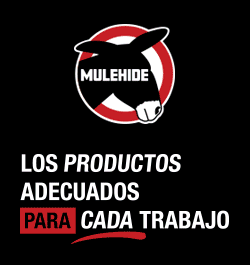




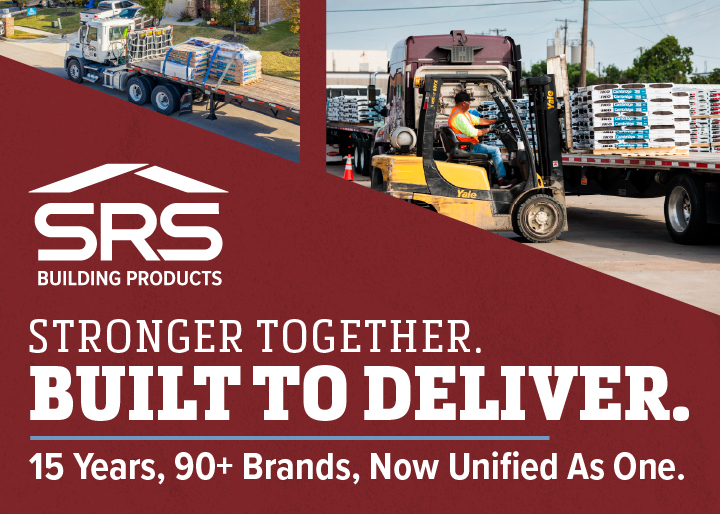
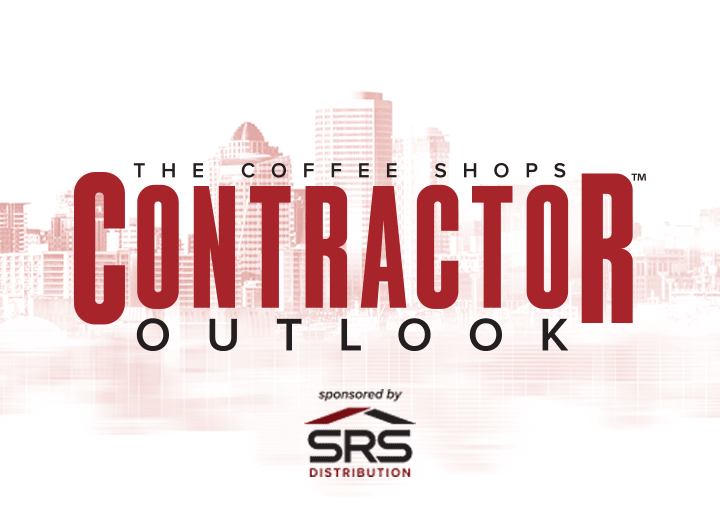


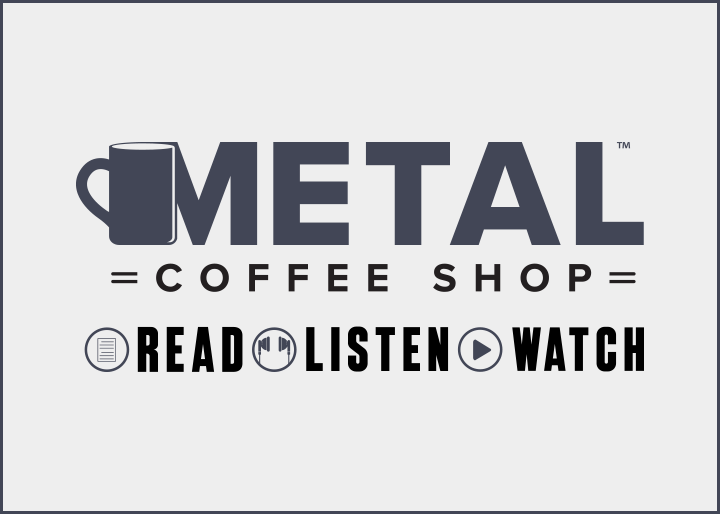

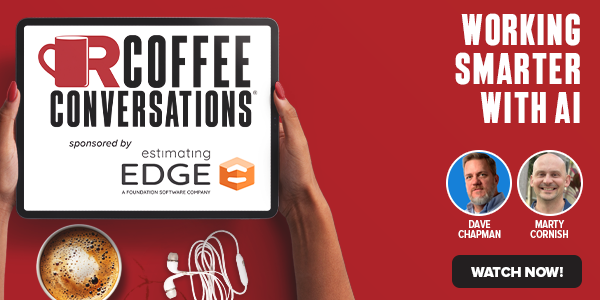

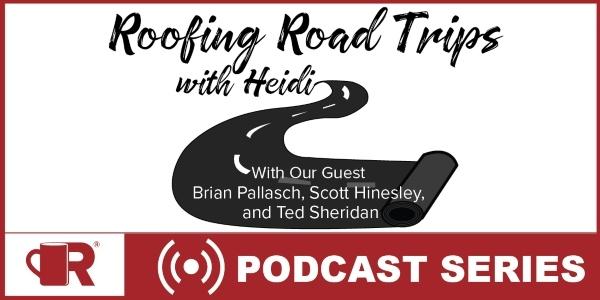
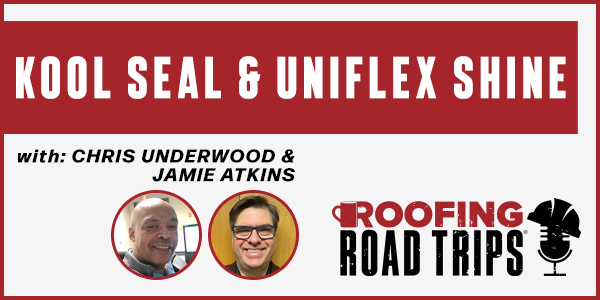



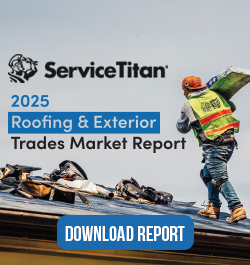


Comments
Leave a Reply
Have an account? Login to leave a comment!
Sign In